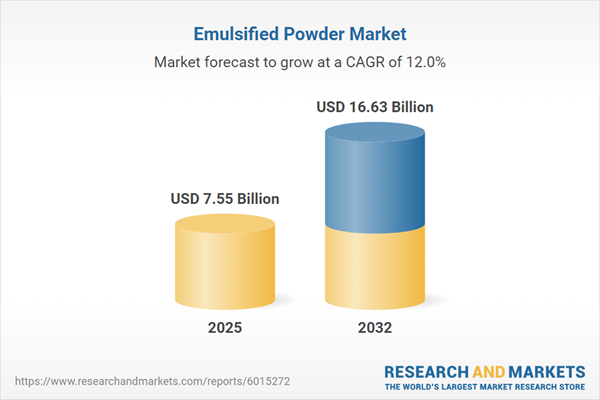Speak directly to the analyst to clarify any post sales queries you may have.
The emulsified powder market is evolving rapidly as organizations embrace emerging technologies, refine operational frameworks, and boost product innovation to meet changing consumer demands and complex regulations. Senior decision-makers require precise, actionable intelligence to steer resilient strategies and maintain competitive agility in this dynamic sector.
Market Snapshot: Emulsified Powder Market Performance and Growth
The global emulsified powder market demonstrated strong momentum, achieving growth from USD 6.73 billion in 2024 to USD 7.55 billion in 2025, marking a compound annual growth rate (CAGR) of 11.95%. Expansion is supported by continuous advances in protein-based formulations, progress in modern drying technologies, and broadening applications across food, beverage, nutraceutical, and infant nutrition domains. Companies are strategically recalibrating product lines to address the move toward clean-label solutions and multifunctional ingredients—a direct response to shifting consumer and regulatory expectations. Competitive positioning now hinges on timely innovation and precise alignment with evolving market requirements.
Scope & Segmentation: Diverse Opportunities and Strategic Priorities
- Product Types: Bakery ingredients, beverage mixes, confectionery elements, dairy alternatives, infant formulas, nutraceutical blends, and sports nutrition or weight management solutions form the market’s core, each offering tailored benefits to specific end-use industries.
- Form Technologies: Drum drying, freeze drying, and spray drying technologies are pivotal, enhancing shelf stability and product uniformity while streamlining manufacturing outcomes for both established and niche applications.
- Carrier Types: Carriers such as coconut, milk, palm, soy, and sunflower provide shelf life optimization and support sustainability commitments, aligning with the environmental objectives of brand owners and manufacturers.
- Protein Sources: The spectrum spans casein, pea protein, soy protein, and an array of whey derivatives, meeting global regulatory requirements and responding to dietary and allergenic considerations across consumer groups.
- End Users: Primary demand is driven by food and beverage manufacturers and retail sector stakeholders, all seeking robust product stability, enhanced taste profiles, and manufacturing efficiency to meet rising market expectations.
- Distribution Channels: Offline venues like hypermarkets and specialty retailers are complemented by digital channels and e-commerce platforms, which increase accessibility for both consumers and professional buyers in new markets.
- Regional Coverage: Robust growth opportunities exist in the Americas (including the U.S., Canada, Mexico, and South America), Europe, the Middle East, Africa, and Asia-Pacific. Local adaptation is crucial as regulations, consumer behavior, and economic climates shift across territories.
- Leading Companies: Market activity is shaped by key enterprises such as Cargill, Archer-Daniels-Midland Company, Kerry Group plc, Ingredion, Tate & Lyle, Roquette, Corbion, International Flavors & Fragrances, BASF, and Koninklijke DSM N.V.—organizations driving technology advances and differentiation strategies.
Key Takeaways: Strategic Insights for Senior Decision-Makers
- Embedding real-time analytics within core drying processes is advancing operational efficiency and strengthening quality controls, which underpins sustainability targets in end-to-end production workflows.
- Shifting toward clean-label and plant-based ingredient portfolios supports compliance with rigorous regulatory frameworks and meets increasing consumer transparency demands.
- Customizing functional formulations in response to contemporary dietary movements ensures that companies are well-positioned for fast adaptation and deeper market penetration.
- Innovations in encapsulation and judicious carrier base selection result in better nutrient retention and improved solubility, both critical for specialty areas such as infant nutrition and performance products.
- Agile supply chain strategies and collaborative alliances enable businesses to address shifts in trade environments and policy adjustments, preserving continuity and resilience during market disruptions.
Tariff Impact: Navigating Changes in Competitive Dynamics
Recent tariff developments in the United States are prompting industry participants to prioritize local and regional sourcing, grow domestic production capabilities, and adjust product strategies. These measures help companies remain flexible against rising input costs, optimize regulatory compliance, and minimize supply chain risks as trade landscapes evolve.
Methodology & Data Sources
This market analysis is built upon qualitative interviews with suppliers and regulatory authorities, combined with exclusive quantitative datasets. Every research phase is fortified by systematic validation and scenario testing, ensuring insights are robust and decision-ready for senior leadership teams.
Why This Emulsified Powder Market Report Matters
- Arms organizational leaders with intelligence to drive sustainable growth and bolster resilience in fluctuating global markets.
- Delivers actionable segmentation and clear regulatory perspectives, informing strategic launches and expansion initiatives in priority regions.
- Facilitates supply chain optimization and risk-mitigation through collaborative and forward-looking operating models.
Conclusion
Ongoing innovation, strategic alliances, and adaptability are foundational to advancing in the emulsified powder industry. Informed approaches and responsive frameworks remain pivotal as market and policy environments continue to evolve.
Additional Product Information:
- Purchase of this report includes 1 year online access with quarterly updates.
- This report can be updated on request. Please contact our Customer Experience team using the Ask a Question widget on our website.
Table of Contents
3. Executive Summary
4. Market Overview
7. Cumulative Impact of Artificial Intelligence 2025
Companies Mentioned
The companies profiled in this Emulsified Powder market report include:- Cargill, Incorporated
- Archer-Daniels-Midland Company
- Kerry Group PLC
- Ingredion Incorporated
- Tate & Lyle PLC
- Roquette Frères S.A.
- Corbion N.V.
- International Flavors & Fragrances Inc.
- BASF SE
- Koninklijke DSM N.V.
Table Information
| Report Attribute | Details |
|---|---|
| No. of Pages | 188 |
| Published | November 2025 |
| Forecast Period | 2025 - 2032 |
| Estimated Market Value ( USD | $ 7.55 Billion |
| Forecasted Market Value ( USD | $ 16.63 Billion |
| Compound Annual Growth Rate | 11.9% |
| Regions Covered | Global |
| No. of Companies Mentioned | 11 |









